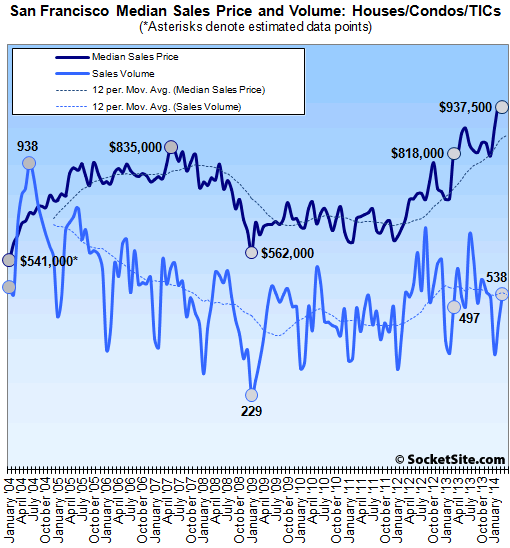
While Bay Area home sales were down 12.9 percent on a year-over-year basis last month, the slowest March in terms of sales volume since 2008, recorded home sales were up 8.2 percent on a year-over-year basis in San Francisco as contracts in a number of new condo buildings started to close (see last paragraph below).
That being said, sales volume in San Francisco has increased an average of 41.1 percent from February to March over the past decade and last month’s gain represented a sub-par seasonal increase of 19.3 percent versus the month before.
The median price paid for a property in San Francisco was $937,500 in March, down 0.8 percent from a record $945,000 in February but 14.6 percent higher year-over-year, driven in part by an increase in the mix of higher priced home sales. As always, keep in mind that while movements in the median sale price are a great measure of what’s in demand and selling, they’re not a great measure of actual appreciation despite what the headlines might say.
Having peaked at $665,000 in July of 2007, the median sale price for a home in the Bay Area increased 7.2 percent to $579,000 in March, up 23.2% year-over-year and the highest median price since December of 2007. The median price had fallen to $290,000 in March of 2009.
With San Francisco the only Bay Area county to have recorded a gain, Napa recorded the second best outcome with respect to sales, dropping 8.5 percent year-over-year. Sales in Solano County were down 28.3 percent in March, the greatest Bay Area decline. The median in Solano was up 30.4 percent to $300,000 in March, the greatest Bay Area percentage gain. The median in San Mateo County was up 13.5 percent to $767,000, the smallest Bay Area gain.
As always, keep in mind that DataQuick reports recorded sales which not only includes activity in new developments, but contracts that were signed (“sold”) months prior but are just now closing escrow (or being recorded) and any properties that were sold “off market.”
Nice numbers.
Median price per sq ft, once oft touted here as a more reliable indicator of prices, looks to be giving a consistent picture as well and also currently sits at record high and seems to be up around 20% YOY.
[Editor’s Note: The median price per square foot remains a much more reliable measure of appreciation when comparing data sets with similar distributions, but it’s susceptible to mix as well, especially if you’re looking at a city-wide number when the upper end of the market is outperforming the bottom and new construction is starting to get mixed in.]
Stats for the Bay Area are meaningless. Please be more location specific.
“….driven in part by an increase in the mix of higher priced home sales.” Also driven in part by the batskit crazy prices people are offering on homes in SF.
“As always, keep in mind that while movements in the median sale …are’re not a great measure of actual appreciation” … they have historically been pretty darn close and directionally correct, and are a good measure to see how the market is performing / has performed overall.
Also, kathleen, the editor has always made the effort to quote broader bay area stats and to parse out the SF specific stats, which are noted in Paragraph 3 in the post above.
“they have historically been pretty darn close and directionally correct, ”
Agreed Eddy. In fact, the position on here when the collapse was happening was that mix was not important to draw attention to when medians and prices were following in the same direction (then, it was downwards).
As opposed to a period in 2008 when medians were slightly up, but prices apparantly down, as mix had a huge focus here then.
Appears now a change in position though now that both things are pointing up, unless its believed that prices aren’t currently rising….?
“In fact, the position on here when the collapse was happening was that mix was not important to draw attention to when medians and prices were following in the same direction (then, it was downwards).
As opposed to a period in 2008 when medians were slightly up, but prices apparantly down, as mix had a huge focus here then.”
You’re disproving your point here.
If median and price were so closely correlated, people would not have spent so much time analyzing and arguing over their differences.
In reality, certain types bring up mix when medians are going up and other types bring up mix (distressed sales, marginal location, not “real SF”,… ) when medians are going down.
Like people who dis-believe supply and demand, there’s no serious case to be made that the median isn’t flawed as a price measure. Nearly all the new price measures that have been developed are repeat sales based ( CoreLogic, LPS, FHFA,…) and even the NAR now concedes the mix issue in their EHS median price reports.